If you’re looking for a new, challenging exercise to add to your routine, you should try side crunches. This exercise works the muscles on the sides of your abs (oblique), which can help give you a slimmer waistline.
The side-to-side crunch is a core exercise that not only strengthens the obliques but also the other muscles in your core.
Oblique crunches can help relieve pressure on the lower back and prevent injury by working the muscles that support and stabilize the spine.
Moreover, strong oblique muscles can improve posture and balance and enhance athletic performance. Therefore, doing side crunches is a good exercise for people of all ages and fitness levels.
However, there’s a variety of crunches for your obliques. So, I’ll show you the best ways to do oblique crunches for a shredded midsection.
In this article, you will learn:
- Know About Oblique Muscles
- What are oblique Side crunches?
- How To Train Oblique With Crunches
- Benefits Of Doing Side Obliques Crunches
- How to do oblique crunches
- Oblique crunch variations

- Know About Oblique Muscles
- External Obliques
- Internal Obliques
- What Is Side Crunches
- How To Do Side Crunches
- Best Variations Of Oblique Side Crunch
- 1. Bent Knee Side Crunch
- 2. Standing Side Crunch
- 4. Side Crunch Leg Raise
- 5. Elbow To Knee Side Plank Crunch
- 6. Standing Cable Oblique Crunches
- 7. Dumbbell Oblique Side Crunch
- Bonus: Seated Wall Side Crunch
- Benefits Of Doing Side Crunches
- Takeaways
- People Also Ask
- Do Side Crunches Help To Love Handles?
- Do side crunches, make your waist smaller
- Do side crunches make your waist wider?
- How many side crunches (reps and sets) should I do
- Can You Do Side Crunches Every day?
- References
Know About Oblique Muscles
There are two different types of obliques — internal and external — and both are part of our core musculature.
External Obliques
The external oblique is the outer visible layer that passes run diagonally on each side of the rectus abdominis. . These muscles help in side-to-side bending, flexion of the spinal column, torso rotation, and compression of the abdomen.
Your internal and external obliques work together to stabilize and brace your core before you swing a baseball bat.
And it’s your external obliques that take advantage of that stability to bring the bat around with as much power as possible.
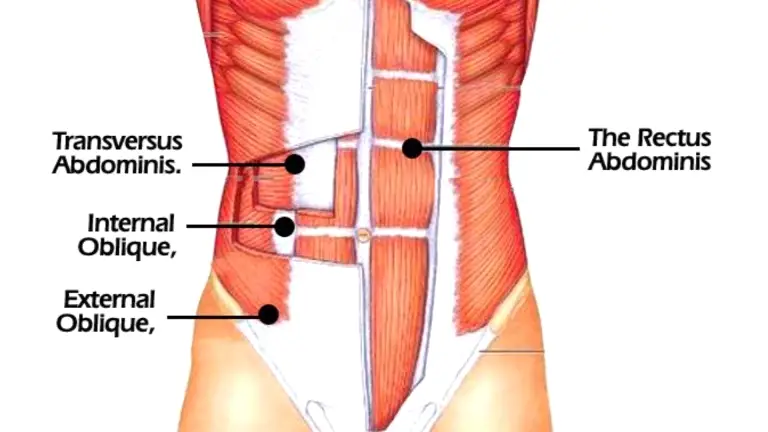
Internal Obliques
The internal oblique muscles lie under the external obliques and run into the lower back or erector spinae.
The fibers of the two muscles pass at right angles to one another; therefore, they are often referred to as opposite-side rotators.
The internal obliques not only rotate your body, they also help to keep you balanced as you move, run, toss a ball, or grab something from the ground.
What Is Side Crunches
Side crunches are similar to regular oblique crunches, except that they include a subtle rotation as you perform the movement. This twisting motion will activate the muscles on the sides of your abdomen.
Obliques Side crunches are also known as side to side crunches exercises are a great way to tone your obliques and help you maintain a fit body.
They are perhaps the most user-friendly workout that you could use at home or in the gym to train your oblique and core muscles.
There are many different ways to perform the side oblique crunch. You can add them to your oblique and abs routine, and they can also help you lose weight.
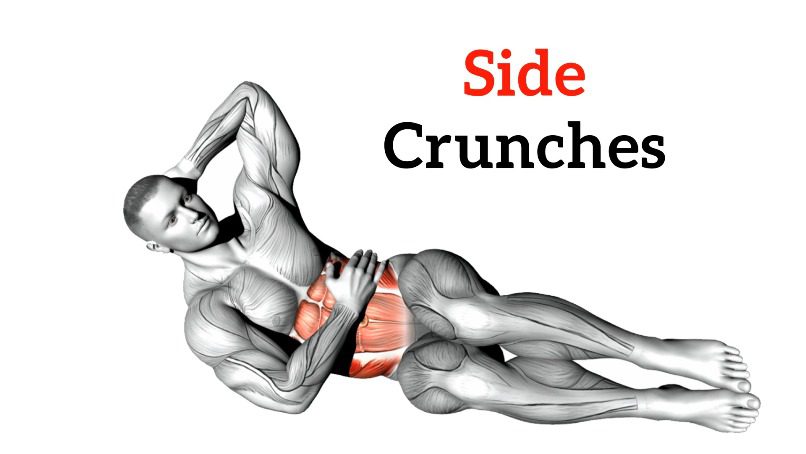
How To Do Side Crunches
You can perform a side crunch with your back on the ground, or you can lift your torso and arms straight up into the air. There are so many ways to do oblique crunches, and there is no wrong way to do them.
You just need to find a variation that is challenging for you.
- You can do oblique crunches with your feet flat on the ground.
- You can put your feet up on a stability ball.
- You can also do side crunches with a weight in your hands to make them even more challenging.
- No matter how you do them, make sure to keep your back straight and your abdominal muscles pulled in.
To get your six-pack abs in shape, you need to master the oblique crunch and then work on a better set of oblique moves.
Try a few different variations to find the one that works best for you. You can also mix up your routine by doing oblique crunches on one day and then doing a different exercise the next day.

Best Variations Of Oblique Side Crunch
There are several variations of the side crunches exercise that not just add variety to your workout, but also give you better results. The side crunch can be done in different ways to suit your fitness level.
- If you are new to performing a side crunch, you may want to apply a few modifications to make the exercise easier. One way to counteract this issue is to perform standing side crunches.
- If you are looking for a more advanced variation to stimulate different muscle fibers in the oblique, then try side crunch leg raise. You can make it more challenging by using weight. But focus on form while doing the same.
Here are the best side crunches exercises you can add to your core routine. Below, we’ve listed beginner, intermediate, and advanced routines to help you get the most out of your oblique workout.
1. Bent Knee Side Crunch
The oblique crunch also known as Lying side crunch is one of the best bodyweight exercises that target your core muscles—specifically the obliques on the sides of your abdomen.
Many abs exercises focus solely on the abs also known as the six-pack. While important, it is also wise to focus on strengthening the rest of the core muscles so that you have a balanced strength.
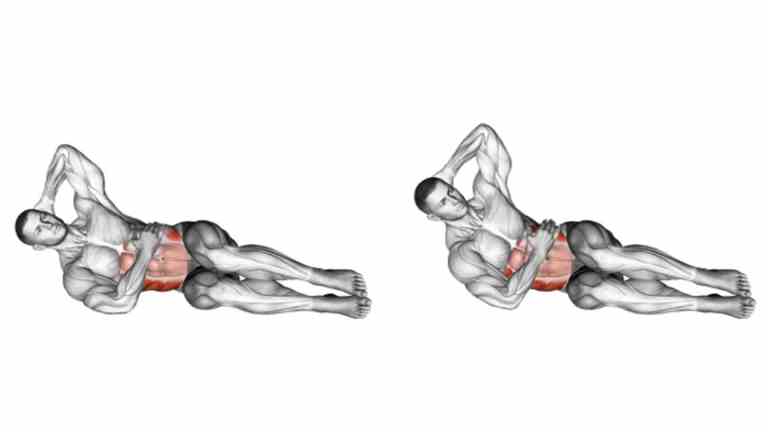
How To Do Bent Knee Side Crunch
- Lie on the floor on your right side with your hips and knees bent.
- Put your left hand behind your head and your right hand across your body on your obliques.
- Placing your hand on your obliques can help you feel the muscles contract and improve the mind-muscle connection.
- Contract your obliques to lift your shoulder off the floor.
- Hold this position for a second, contracting your obliques as hard as possible.
- Then return to the start position.
- Do all of the reps on the left side, and then do the same number of reps on the right side.
2. Standing Side Crunch
Oblique crunches done while standing help build strength and stability in the obliques and abdominal muscles. Oblique standing crunches also do an excellent job of improving balance.
Whether you are a beginner or an experienced exerciser, these crunches are a great addition to your routine.

How To Do Standing Oblique Crunch
- Get into a standing position with your knees slightly bent, your feet hip-width apart, and your hands behind your head.
- Bend your left knee and shift your weight to the left.
- Then, crunch to the right side and bring your right knee up toward your elbow.
- Return to the starting position by lowering your right leg.
- Switch your legs and repeat until the set is over.
4. Side Crunch Leg Raise
One exercise that trains both the internal and external obliques, as well as other abdominal muscles, is the side crunch leg raise, also known as a side jackknife crunch. It is a moderate-level oblique exercise that only requires the use of a mat.
Once you master the basic oblique V-up, you can increase the difficulty of the exercise by raising both legs off the ground.
The double side jackknife follows all the same steps as the side jackknife, except that you bring both your feet up while you raise your upper body.

How To Do Oblique V-up
- Lie on your left hip, legs together and right leg on top of your left.
- Place your right hand behind your head and your left elbow stays close to your body for support.
- Use your oblique muscles to raise your top leg while simultaneously raising your torso to meet it.
- Lower in a controlled motion and repeat, until you complete your set. Then switch sides and repeat.
5. Elbow To Knee Side Plank Crunch
The elbow To knee side plank crunch is a brilliant bodyweight exercise that helps you to develop the strength and stability of your core.
Combine your standard crunches with side plank exercise into one move that will challenge your balance, tone up your waist, and strengthen your core.
Side plank crunch works your whole body by combining all the core actions you get from a traditional plank with some extra love for your shoulders and hips. Your obliques get hit doubly hard in this exercise.
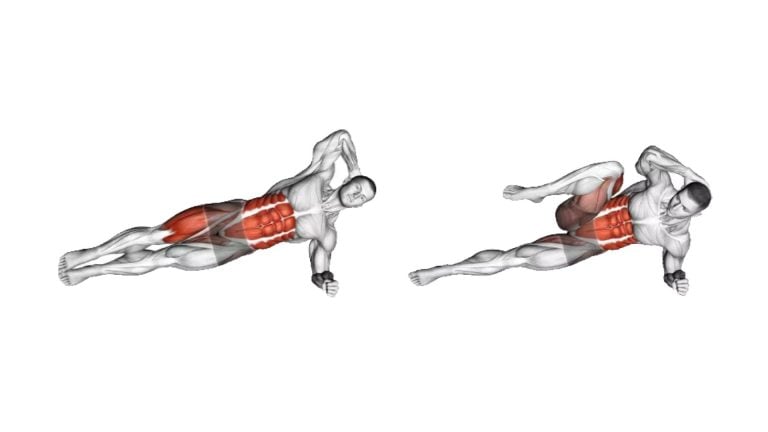
How To Do Elbow To Knee Side Plank Crunch
- Lie on your right side on the floor with your left foot on top of your inner side and your left arm on top of your left side.
- Raise your body by placing your right forearm flat on the floor so that it’s perpendicular to your torso.
- Lift your torso until your right upper arm is straight underneath you with your elbow bent 90 degrees and your forearm flat on the floor. Extend your left arm over your head.
- Lift your left leg and drive your knee toward your torso. At the same time, bring your left arm in toward your knee in a crunch movement.
- Continue for a set amount of time, and then repeat on the other side.
6. Standing Cable Oblique Crunches
When doing an oblique workout with a cable machine, there are plenty of single-arm exercises you can add to correct potential imbalances.
The standing cable side crunches are also a popular and effective exercise that works your oblique muscles. You can include these exercises in your cable workout routine.
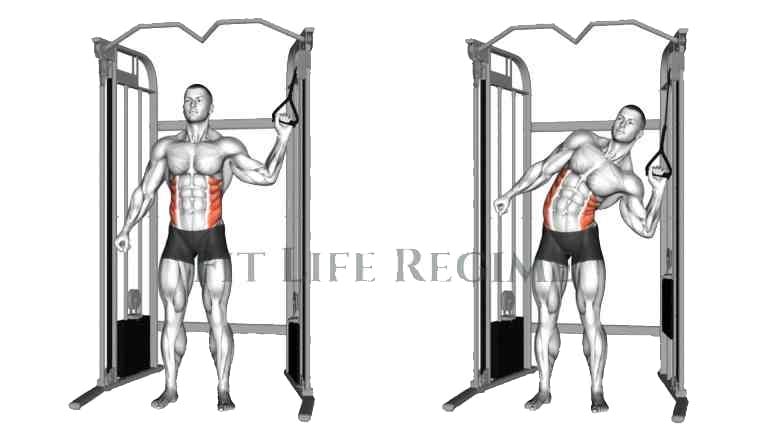
How To Do Standing Cable Side Crunch
- Attached D-handle to a high pulley and stood side-on to the weight stack.
- Grasp the D-handle with your left hand and stand with the pulley to your left side.
- Make sure your forearm is positioned at an angle of 90-degrees to the upper arm and your feet firmly placed on the floor at shoulder width.
- With your head up and back straight, pull the weight down using your left oblique muscle as far as you can.
- Pause for a second and then return to the initial position.
- Repeat for the desired number of repetitions. Turn around and repeat the cable side bend with your left side.
7. Dumbbell Oblique Side Crunch
The dumbbell oblique crunch is effective at targeting the internal and external obliques. Strengthening the lateral flexion of your spine, improving spinal mobility, and helping to develop a strong and stable core.
If you’re new to the exercise, practice the movement with your bodyweight alone.
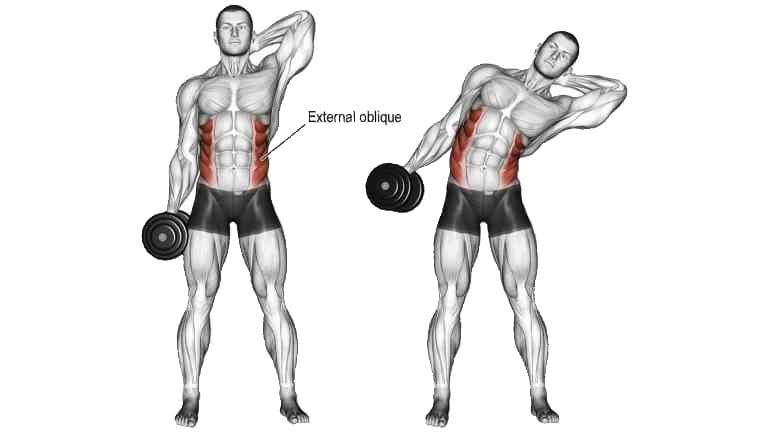
How To Do Dumbbell Side Crunches
- Stand with your feet shoulder-width apart while holding a dumbbell with a neutral grip in your right hand with your arm hanging at your side. You can place your free hand behind your head.
- Bend sideways at the waist to the left as low as possible, using your oblique muscles to pull your torso down.
- Hold for a second and return to the starting position.
- Complete the desired number of reps and repeat on the other side.
Bonus: Seated Wall Side Crunch
Wall seated side crunch is an advanced exercise developed to shape, tighten and strengthen abs and oblique muscles.
To take the exercise to a higher level, you can make the movement difficult by taking a weight in your hand.
In addition, exercise can help increase the endurance of the leg muscles by providing an isometric contraction.
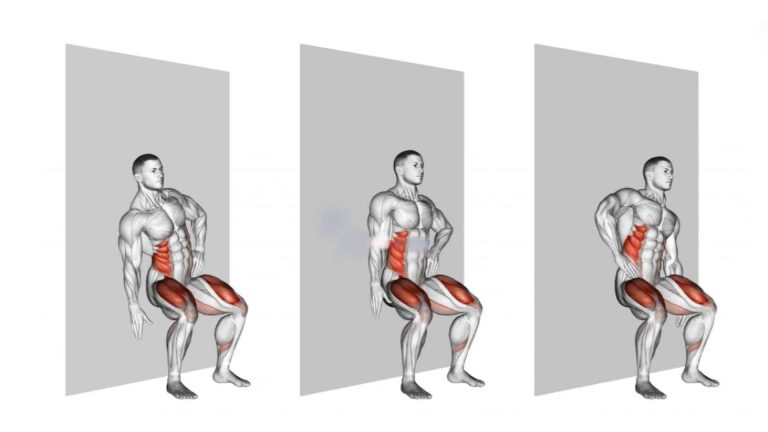
Benefits Of Doing Side Crunches
Side crunches emphasize the sides of your abdominal to help you build lean, strong muscles. When done correctly, this type of exercise can be an effective way to tighten your side abs.
- The oblique side strengthens your back, tenses your core, tones your abs, and enhances your balance and flexibility.
- This is an excellent exercise to correct postural problems. It helps prevent and manage lower back pain and stiffness.
- An oblique workout will help you get rid of that stubborn fat around your midsection by strengthening these muscles.
- Side crunches help build obliques and abdominal muscles for strength and stability. It is an excellent way to improve balance.
- Working out the side muscles helps balance out strength in your body, improves posture and reduces stress on your spine from carrying excess weight in that area.
- One of the most important side benefit of side crunches is that they give you a strong core. This will give you a toned appearance, reduce the risk of injuries, and enhance your balance.
- Aside from their physical benefits, oblique crunch can also have a positive impact on your mental health. Exercise has been shown to improve your mood and reduce stress, and oblique crunches are no exception.
- In order to effectively train the core, you need to challenge it from different angles. This exercise helps to work different muscles from different angles.
Takeaways
The side crunch strengthens your back, strengthens your core, tones your abs, and enhances your balance and flexibility. When done properly, the side crunch exercise strengthens your core better than anything else.
However, to get the most out of this exercise, please make sure to modify it according to your individual needs and fitness objectives.
Once you have learned a few floor-based oblique crunches, you can try a stability ball side crunch or weighted side crunches variation, which puts more demands on your core and stabilizer muscles.
People Also Ask
Do Side Crunches Help To Love Handles?
Side crunches are a good exercise that help you lose love handles. But in order to permanently get rid of your love handles, you will need to make dietary, exercise and lifestyle changes.
Do side crunches, make your waist smaller
Side crunches are effective for training the oblique and core muscles, which will help improve the shape and tone of the waistline. It also helps to get rid of the extra layer of fat around the waistline.
Along with this, cardiovascular exercise, resistance training, and healthy eating are the most effective methods for reducing body fat and reducing the width of your waist.
Do side crunches make your waist wider?
Side crunches will not make you bigger and wider, if you train with optimum weight and with good form. Avoid using a heavy weight for this exercise.
How many side crunches (reps and sets) should I do
Choose how many sets and reps you want to do based on how good you can keep your technique while doing the core workout. Start with 2–3 sets of 10–15 reps on the left and right side.
Can You Do Side Crunches Every day?
No, you should not do side crunches every day, muscles need 36 to 48 hours to recover. If you are planning to include side crunches in your routine, then you should do them at least 2-3 times per week, on nonconsecutive days.
References
- Nakai Y, Kawada M, Miyazaki T, Araki S, Takeshita Y, Kiyama R (2021) A self-oblique exercise that activates the coordinated activity of abdominal and hip muscles–A pilot study. PLoS One 16(8): e0255035.
- Whiting, W. C., Rugg, S., Coleman, A., & Vincent, W. J. (1999). Muscle activity during sit-ups using abdominal exercise devices. Journal of Strength and Conditioning Research, 13(4), 339-345.

Manish brings over 10 years of hands-on experience in weight lifting and fat loss to fitness coaching. He specializes in gym-based training and has a lot of knowledge about exercise, lifting technique, biomechanics, and more.
Through “Fit Life Regime,” he generously shares the insights he’s gained over a decade in the field. His goal is to equip others with the knowledge to start their own fitness journey.
